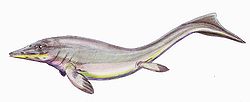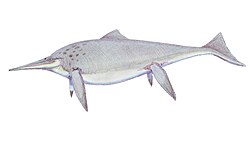| Wahlisaurus Temporal range: Early Jurassic, | |
|---|---|
 | |
| Life reconstruction of the Wahlisaurus massarae holotype individual | |
| Scientific classification | |
| Kingdom: | Animalia |
| Phylum: | Chordata |
| Class: | Reptilia |
| Order: | † Ichthyosauria |
| Family: | † Leptonectidae |
| Genus: | † Wahlisaurus Lomax, 2016 |
| Type species | |
| †Wahlisaurus massarae Lomax, 2016 | |
Wahlisaurus is an extinct genus of leptonectid ichthyosaur from the Scunthorpe Mudstone of England. [1] The type species is Wahlisaurus massarae, and two specimens have been found: the first consisting of a skull and an incomplete skeleton, and the second a single coracoid. [2]








